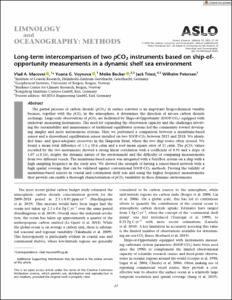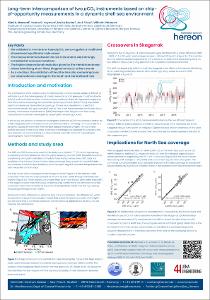| dc.contributor.author | Macovei, Vlad A. | |
| dc.contributor.author | Voynova, Yoana G. | |
| dc.contributor.author | Becker, Meike | |
| dc.contributor.author | Triest, Jack | |
| dc.contributor.author | Petersen, Wilhelm | |
| dc.coverage.spatial | Skagerrak Strait | en_US |
| dc.date.accessioned | 2021-10-29T16:28:46Z | |
| dc.date.available | 2021-10-29T16:28:46Z | |
| dc.date.issued | 2021 | |
| dc.identifier.citation | Macovei, V.A., Voynova, Y.G., Becker, M., Triest, J. and Petersen, W. (2021) Long-term intercomparison of two pCO2 instruments based on ship-of-opportunity measurements in a dynamic shelf sea environment. Limnology and Oceanography: Methods, 19, pp.37-50. DOI: https://doi.org/10.1002/lom3.10403 | en_US |
| dc.identifier.uri | https://repository.oceanbestpractices.org/handle/11329/1766 | |
| dc.description.abstract | The partial pressure of carbon dioxide (pCO2) in surface seawater is an important biogeochemical variable
because, together with the pCO2 in the atmosphere, it determines the direction of air–sea carbon dioxide
exchange. Large-scale observations of pCO2 are facilitated by Ships-of-Opportunity (SOOP-CO2) equipped with
underway measuring instruments. The need for expanding the observation capacity and the challenges involving
the sustainability and maintenance of traditional equilibrator systems led the community toward developing
simpler and more autonomous systems. Here we performed a comparison between a membrane-based
sensor and a showerhead equilibration sensor installed on two SOOP-CO2 between 2013 and 2018. We identified
time- and space-adequate crossovers in the Skagerrak Strait, where the two ship routes often crossed. We
found a mean total difference of 1.5 ± 10.6 μatm and a root mean square error of 11 μatm. The pCO2 values
recorded by the two instruments showed a strong linear correlation with a coefficient of 0.91 and a slope of
1.07 (± 0.14), despite the dynamic nature of the environment and the difficulty of comparing measurements
from two different vessels. The membrane-based sensor was integrated with a FerryBox system on a ship with a
high sampling frequency in the study area. We showed the strength of having a sensor-based network with a
high spatial coverage that can be validated against conventional SOOP-CO2 methods. Proving the validity of
membrane-based sensors in coastal and continental shelf seas and using the higher frequency measurements
they provide can enable a thorough characterization of pCO2 variability in these dynamic environments | en_US |
| dc.language.iso | en | en_US |
| dc.rights | Attribution 4.0 International | * |
| dc.rights.uri | http://creativecommons.org/licenses/by/4.0/ | * |
| dc.subject.other | Ships of Opportunity | en_US |
| dc.subject.other | Voluntary ships | en_US |
| dc.subject.other | SOOP | en_US |
| dc.subject.other | FerryBox | en_US |
| dc.title | Long-term intercomparison of two pCO2 instruments based on ship-of-opportunity measurements in a dynamic shelf sea environment. | en_US |
| dc.type | Journal Contribution | en_US |
| dc.description.refereed | Refereed | en_US |
| dc.format.pagerange | pp. 37–50 | en_US |
| dc.identifier.doi | 10.1002/lom3.10403 | |
| dc.subject.parameterDiscipline | Chemical oceanography | en_US |
| dc.subject.dmProcesses | Data acquisition | en_US |
| dc.bibliographicCitation.title | Limnology and Oceanography: Methods | en_US |
| dc.bibliographicCitation.volume | 19 | en_US |
| dc.description.sdg | 14.a | en_US |
| dc.description.eov | N/A | en_US |
| dc.description.methodologyType | Method | en_US |
| dc.description.methodologyType | Reports with methodological relevance | en_US |
| obps.contact.contactname | Vlad Macovei | |
| obps.contact.contactemail | vlad.macovei@hzg.de | |
| obps.resourceurl.publisher | https://aslopubs.onlinelibrary.wiley.com/doi/full/10.1002/lom3.10403 | |
 Repository of community practices in Ocean Research, Applications and Data/Information Management
Repository of community practices in Ocean Research, Applications and Data/Information Management


